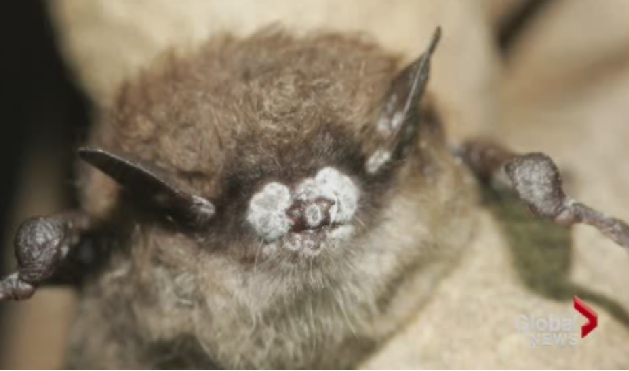A deadly bat disease that has recently been found in Washington State, could be a disaster for the bat population in B.C.

White-Nose Syndrome is a deadly fungus that kills bats and there is currently no known cure.
The disease has nearly wiped out bats in eastern Canada and in New Brunswick, it’s estimated about 99 per cent of little brown bats have died.
With the discovery of a dead bat near Seattle, Washington, with the disease, scientists in B.C. are now very concerned it will spread to our province and wipe out our bat population.
“At this point we’re all pretty much in panic mode,” said Cori Lausen, associate conservation scientist with the Wildlife Conservation Society Canada. “We thought we had 10 years. This disease was supposed to stay in the east and gradually spread across the Great Plains, maybe not even get across the Great Plains because it’s a dry environment, fungus wouldn’t grow well. So to just have it suddenly show up on the coast, yeah, it’s really changed our world.”
Lausen, along with other scientists and the funding from the Habitat Conservation Trust Foundation (HCTF), has started a new program, the BatCaver project, to count and monitor bats in B.C.
“There’s two components of this and that is using bat detectors to count bats and using people to count bats,” said Lausen.
“The bat detector component, as you can imagine, is the more difficult part of this because it requires people to know how to use specialized equipment that records that ultrasound.”
“And so I’m spending a lot of my time now training people how to do that.”
Once those people are trained, they will get a section of land to monitor and the data is then submitted to the B.C. Government and the U.S. Geological Survey.
Another component is having people volunteer to count bats where they know bats roost.
“It’s important because White Nose Syndrome is likely going to drastically impact our bats but at this point we don’t know which species and where,” said Lausen. “There’s a really good chance, based on the preliminary information we have, coming out of eastern Canada, that not all of our species are going to be hit equally hard and not all areas will be hit hard.”
“We want to try to understand the impact of the disease. Where is it impacting and what species is being affected.”
Brian Springinotic, CEO of the HCTF, said they have funded supporting work about bats in the last few years, but now they need to focus on identifying critical bat habitats.
“To get a base line. Where are these bats? Where do they live? Where are their winter hibernacula? How many bats? Which species are there? Because we don’t really know,” he said.
“Because of the fear that White Nose Syndrome will spread to British Columbia.”
Anyone can find out more about bats in B.C. and how to help them by going to the website bcbats.ca.
Lausen said, now, it’s important to change people’s perceptions about bats.
“What I’m finding is really turning the public around right now is that they’re realizing some of the importance of bats,” she said.
“If we don’t have natural pest control, then we are going to see a rise in insects, we’re going to see a rise in damage to forests and crops.”
Lausen said if White Nose Syndrome hits B.C. the entire ecosystem is going to be affected.
“If we start to get an imbalance of nighttime insects, what are the cascading effects? We’re talking, some of these species of bats, it could be 90 per cent of the population that is affected,” she said.
Learn more about the BatCaver project.
“The bats need all the help they can get,” said Lausen.
The HCTF is currently funding about 120 projects across B.C., including two about bats.
“We have a proposal-driven business model and we get about 200 proposals a year,” said Springinotic.
Most of the money comes from a surcharge on angling, hunting, trapping and guide outfitting licences. Between 20 and 25 per cent of that money goes to HCTF.
“It’s a philosophical belief that we need to sustain all of the diversity of British Columbia’s wildlife and habitat,” added Springinotic.
“People only care about what they know about and the more we can connect people to species and habitats, the more they know about these things and the more they’re going to care about these things.”
“And British Columbians have shown that they absolutely do care about this stuff.”



Comments